

A description of the completed construction was published in the Povodí Vltavy state enterprise newsletter. The design and purpose of both migration barriers were discussed at project seminars on 4 April in České Budějovice and 11 April in Prague. In April 2024, permanent information boards with text about barriers and the risk of the spread of non-native crayfish species were placed at both steps.
In winter, an analysis of eDNA samples taken in summer 2023 was conducted on three Zákolanský stream profiles: Zákolany/Otvovice, below the confluence with the Knovízský stream, and above the confluence of the Zákolanský stream with the Vltava. The results did not confirm the occurrence of spinycheek crayfish in the Zákolanský stream, except for the last monitoring profile located about 10 m above the confluence with the Vltava. A weak but consistent stone crayfish and noble crayfish eDNA signal was recorded in Zákolany. Below the confluence with the Knovízský stream, a very weak noble crayfish signal was recorded, as well as trace amounts of stone crayfish eDNA beyond the limit of reliable detection. The analyses results indicate that the invasive spinycheek crayfish spends most of its time in its usual habitat in the Vltava and in the Zákolanský stream only above the confluence with the Vltava. The detection of stone crayfish is an expected positive result, as well as noble crayfish, which was reported from the Zákolanský stream in the past.
On 20th June 2023, environmental DNA was sampled on three profiles (Zákolany/Otvovice above the step, above the confluence with Knovízský stream, at the confluence with the Vltava). The samples are still being processed by the subcontractor (Faculty of Science, Charles University).
Povodí Vltavy, State Enterprise selected a contractor (Traton s.r.o.) and obtained all necessary permits for the modification of both migration barriers. Construction work began in October with a survey of the section of Zákolanský stream between the modified step and the confluence with Dřetovický stream. 41 stone crayfish individuals were found in the gravel-stone alluvium below the stilling basin of the step. The crayfish were relocated higher up in a suitable section of the riverbed. The purpose of both barriers was the addition of an overhanging barrier to the existing steps on the stream. The first of them is located above the aforementioned confluence with Dřetovický stream (50.18314N, 14.24807E), the second is located lower down, between the villages of Zákolany and Otvovice (50.20297N, 14.25639E). The barriers should prevent the upstream migration of non-native crayfish, but also prevent the return of stone crayfish that would encounter spiny-cheek crayfish infected with crayfish plague. In addition to the spillway, the adjacent walls of the stilling basin were also secured. In both cases, the measures taken will protect the stone crayfish population living on the top part from crayfish plague.
An article was written about the implemented measure, which was published on the websites of local municipalities (Zákolany, Svrkyně). A meeting with residents, where the modification of both steps was presented, took place in the spring. Another article was also written for the Povodí Vltavy newsletter. Placement of information signs near both migration barriers is under discussion with the municipality of Zákolany and Povodí Vltavy, State Enterprise.
During the summer months, environmental DNA (eDNA) samples were collected in Zákolanský stream. In Zákolanský stream, very weak signs were recorded with the stone crayfish probe. In this stream, the occurrence of a fairly stable population of stone crayfish is confirmed about 3 km above the eDNA sampling location, so it is probable that the weak sign is from this population. Samples were taken in several places up to the confluence with Knovízský stream. No samples contained spinycheek crayfish DNA. Further sampling will be carried out above the confluence of Zákolanský stream and the Vltava.
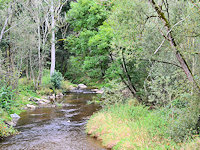
The results and experience gained in efforts to regulate the non-native crayfish population by catching were discussed at project seminars in České Budějovice and in Prague, especially with regard to the measures implemented as part of the freshwater pearl mussel rescue programme.
In April 2024, a permanent information board warning about the occurrence and risks caused by the spread of non-native signal crayfish was installed at the Cetviny border crossing.
In the period from 1/6/2023 to 19/9/2023, 5 trips took place, during which 40 bait traps were laid each time. A total of 548 signal crayfish were caught in bait traps, and 95 signal crayfish were caught during two manual catches.
At the beginning of June, when the water level was high and the temperature was low, the success in catching crayfish was very low. The greatest success was achieved by catching in bait traps between July (CPUE = 4) and August (CPUE = 4 or 5.25 individuals per one bait trap).
Most crayfish were found around the ponds (48.61435N, 14.53224E). Above the ponds, the CPUE reached 7.8; below the ponds, the CPUE was 6.8. Crayfish catches have confirmed that crayfish have also moved further downstream. In the section above Maltschstrasse no. 18 (48.61615N, 14.52124E) in August 2017, we caught only 1 crayfish from 3 bait traps (CPUE = 0.33). In 2023, there were already 46 crayfish from 6 bait traps (CPUE = 7.7). Similarly, no crayfish were caught below the mouth of the Mardesbach tributary in 2017, while 12 crayfish were caught in 10 bait traps in August 2023 (CPUE = 1.2).
Catches were carried out in cooperation with a partner from Austria (blattfisch e.U.), who provided data on the distribution of signal crayfish in the Austrian part of the basin and communicated with local residents and fishing right owners. For distribution and use in educational activities, we handed over some copies of the project calendars and the "Domestic vs. invasive crayfish in the Czech Republic" leaflet.
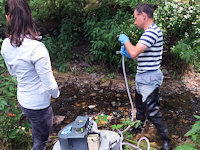
A weak signal of the causative agent of crayfish plague, Aphanomyces astaci, was recorded at the limit of detection in the Kublovský stream, and only a trace amount of Aphanomyces astaci in the Bzovský stream (inconclusive results). A weak signal of Aphanomyces astaci at the limit of detection and a weak (but consistent) eDNA signal of noble crayfish were recorded in the Stroupínský stream. In the closing section of the Stroupínský stream SCI, a weak signal of Aphanomyces astaci was recorded beyond the limit of detection, plus trace amounts of stone crayfish (inconclusive) and noble crayfish (slightly stronger) eDNA. The results show that even after five years the crayfish plague still persists in the basin, but a residual population of both noble crayfish and stone crayfish has probably been preserved here.
During the crayfish plague outbreak in Stroupínský stream SCI in 2018, a rescue transfer of stone crayfish from the Bzovský stream took place. It was possible to save 250 crayfish that were not infected with the pathogen Aphanomyces astaci. Unfortunately, eDNA samples from spring 2023 at the Tyterský stream, where these stone crayfish were introduced in 2020, did not confirm the crayfish occurrence.
Results from the Stroupínský stream basin were presented at project seminars in České Budějovice and Prague. Their presentation at the International Association of Astacology conference held in September 2024 in Zagreb, Croatia is also planned (https://iaa24.biol.pmf.hr).
Further monitoring took place in the summer months using environmental DNA (eDNA). The samples did not confirm the occurrence of invasive or native crayfish, nor the occurrence of crayfish plague (Aphanomyces astaci). Very weak signs were recorded with the stone crayfish probe in Kublovský stream. From the results, it cannot be confirmed with certainty that the stone crayfish still occurs in Kublovský stream. This will be verified in the spring and autumn of 2023.
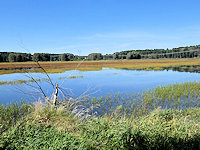
Analysis of stable carbon and nitrogen isotopes was used to describe the food web, determine the food preferences of the signal crayfish (Pacifastacus leniusculus), and the eradication potential of individual fish species on the signal crayfish population in Kačležský pond.
The food web of the Kačležský pond consists of apex predators including pike, pike perch, wels catfish, and perch. In the next trophic level, there are coarse fish species, and below them is common carp. The position of the signal crayfish in the trophic chain is between the common carp and the group of coarse fish. In the lower levels of the food chain, there are zooplankton, macrozoobenthos, raiding insects, detritus, and grain, which is used to feed the carp.
The diet of juvenile and adult signal crayfish was quite similar. For both age categories, the main food component was macrozoobenthos and grain, which was primarily intended as food for the common carp stock. Cannibalism was relatively low in both age stages. Other food components such as sedimenting zooplankton, raiding insects and detritus were relatively marginal sources of food.
The investigated fish species had different eradication potential on the signal crayfish population. Wels catfish, pike, and pike perch proved to be the species with the best eradication potential. Ruffe and perch were less specialized on signal crayfish as food. The pumpkinseed had a significant effect on juvenile signal crayfish; however, it is another invasive species. Common carp in the Kačležský pond proved to be an insignificant species for signal crayfish eradication.
The study confirms that the pike perch released into the pond in 2022 was an appropriately chosen invasive crayfish predator. The high proportion of fodder grain in signal crayfish diet is in agreement with field experience that the best catches in fish traps can be achieved with a break in feeding for a few days.
The study results were presented at project seminars on 4 April in České Budějovice and 11 April in Prague.
The food web of the Kačležský pond analysis: pdf document (399 kB, Czech)
The translation of the text is being prepared...
During the field work, temporary information signs were installed at the sites. Great emphasis was placed on informing the public before Kačležský pond was fished. This is the period when the lay public can easily find crayfish on the exposed pond bottom. With an information campaign, we drew attention to the danger arising from the spread of invasive crayfish. The signs were placed not only in the area of the dam, but also on notice boards of the surrounding municipalities and settlements (Horní Pěna, Číměř, Kunějov, Člunek, Kunžak).
Information signs were also added in the section of experimental works on the Besének watercourse and on the Zákolanský stream in places where the steps were adjusted.
Recommended criteria for evaluating population density (according to Johnsen, S.I., online):
C/TN (Number of crayfish / Number of bow-nets):
C/TN < 0.5: very low population density
0.5 < C/TN < 2.5: low to medium population density
2.5 < C/TN < 5: high population density
C/TN > 5: very high population density
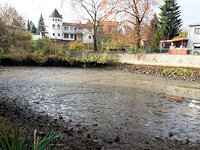
The city of Prague will continue to manage the pond with its own efforts. The management means continuous monitoring of the marbled crayfish occurrence and maintaining a high predation pressure with the help of fish stock.
The progress and experience with the eradication measures in Prostřední pond was summarized in the manuscript “Difficult to deal with: attempts for eradication of marbled crayfish from a small urban pond” submitted to the journal Management of Biological Invasions.
In June 2023, a small population of marbled crayfish was confirmed by the discovery of one individual about 3 cm in size. However, the population remains small; no crayfish have been caught in the bait traps. Even eDNA sampling in the pond and the adjacent Drahanský stream and water bodies in the vicinity did not reveal the presence of marbled crayfish. Thus, its population was probably isolated to Prostřední pond and is now limited by stocked fish predation. The manager of the pond, Prague City Hall, has desisted from further fishing for the time being.
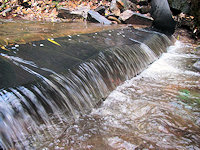
The evaluation showed that the construction of barriers significantly slowed down the upstream migration of signal crayfish (by almost 60%). At the same time, it is clear that the installed barriers on the steps were not 100% insurmountable for crayfish. Some crayfish were still able to overcome the barriers, but in lower numbers than in the previous year, when obstacles were not built on the steps. The tested barriers therefore proved to be a relatively cheap and quick tool that could be used in locations where the migration of invasive crayfish could threaten the native crayfish population, either through the introduction of crayfish plague, or direct competition. By combining other elements during the construction, such as covering the step with smooth material and anchoring it with rough material (stones, gravel) in the upper part of the step, it would be possible to increase the effectiveness of the barrier even more.
The completed analysis of eDNA samples from the Besének confirmed the results of previous hand captures. Samples from sites around Dolní Žleby (above all steps) showed consistent detection of noble crayfish, while signal crayfish eDNA was captured in only one sample, which indicates a rather inconclusive capture. Samples from the vicinity of the lower two barriers showed capture of signal crayfish together with noble crayfish; however, its eDNA may have been washed from areas of occurrence located higher upstream. In the Besének, no Aphanomyces astaci DNA was detected in any of the samples, which also confirms earlier negative testing for this pathogen directly from signal crayfish in 2018. The occurrence of crayfish plague was confirmed in an eDNA sample from the Svratka above the confluence with the Besének from autumn 2023. Aphanomyces astaci was also detected in the Bystřice, where the noble crayfish population was affected by crayfish plague in summer 2023. It was also possible to determine the crayfish plague genotype, the most common carrier of which is signal crayfish. At the same time, a strong noble crayfish signal was detected in the Bystřice, which confirms that the crayfish plague is still ongoing there. Aphanomyces astaci DNA was detected in the Svratka up to the confluence with the Besének, together with a strong signal of signal crayfish DNA and a weak signal of noble crayfish. The occurrence of noble crayfish is assumed in the tributaries of the Svratka (Bystřice, Hodonínka, Chlébský stream, Nedvědička). Due to the confirmed occurrence of the crayfish plague in the Svratka, all tributaries of the Svratka with the occurrence of noble crayfish are at risk of crayfish plague outbreak. In addition to the Besének, there are also tributaries Lubě, Bílý stream, Veverka, Rakovec, and Vrbovec.
In spring 2024, two trips were made to the site. The first was aimed at checking obstacles after the winter and supplementing the missing project documentation. The second included regular maintenance, during which the information signs were renewed; in addition to that, the SFŽP project manager, Mgr. Helena Kaňková, was invited for a monitoring visit.
The migration study results were presented at project seminars in April in České Budějovice and in Prague. At the same time, a contribution is being prepared from the data for the "Innovation in environmental protection" conference, which will be held on 4–5 June in Prague.
From May to October 2023, a total of 5 trips to the site were made, during which 977 signal crayfish individuals were caught, marked, and released back. In the second half of the year, only catches without marking were carried out (the crayfish were then removed from the site and killed by freezing), during which 2,513 individuals were caught (both by hand fishing and by catching in bait traps), of which 317 were marked.
Together with 1069 individuals marked in 2022, a total of 2046 crayfish were marked and returned to the stream in both years. Total number of crayfish caught was 4,559.
Recapture results unfortunately still indicate a very strong population. At the same time, it was proven that the installed barriers on the steps are not 100% insurmountable for crayfish. The effect of obstacles on reducing upstream migration will be evaluated in the coming months.
The experimental work was supplemented by a survey of the occurrence of invasive signal crayfish and native crayfish in the basin. Unfortunately, at the end of May the occurrence of signal crayfish was proven in the vicinity of the highest barrier in Dolní Žleby. Two signal crayfish individuals were found just above the step. An interesting result was the discovery of a larger number of noble crayfish individuals in the vicinity of the step (8 individuals below the step, 2 individuals above the step). The populations of both crayfish species are therefore in contact there. The occurrence of both species here was also confirmed by the results of the May and October eDNA sampling.
At the site of experimental work, information signs were installed and we distributed the remaining "Crayfish 2023" calendars and "Domestic vs. invasive crayfish in the Czech Republic" leaflets to the locals.
During the summer of 2022, an abundant population of signal crayfish was detected by hand fishing at the height of the cottage settlement above the confluence with the Chrastová stream. Higher towards the confluence with the Kozárovský stream, the population decreased and no signal crayfish was found below Dolní Žleby. Later analysed eDNA samples showed occurrence of signal crayfish in the entire monitored section, albeit with decreasing intensity upstream.
In order to limit migration higher up into Besének basin, the three existing steps were modified on the stream between the aforementioned cottage settlement and Dolní Žleby. Using a plastic board, an overhanging overflow edge was created with a freely falling jet of water, and the adjoining bank was also equipped with a plastic barrier limiting the migration of crayfish on land. In the autumn before the described modifications were made, a study was carried out which, using crayfish markings with coloured elastomers, proved that the steps were not a major migration obstacle for crayfish. In 2023, the study will be repeated to determine to what extent upstream migration of invasive crayfish has been reduced.

During the last monitoring period at Stroupínský stream SCI, an analysis of eDNA samples taken in summer 2023 on the Stroupínský stream and its tributaries Bzovský and Kublovský/Pařezový stream was conducted.
A weak signal of the causative agent of crayfish plague, Aphanomyces astaci, was recorded at the limit of detection in the Kublovský stream, and only a trace amount of Aphanomyces astaci in the Bzovský stream (inconclusive results). A weak signal of Aphanomyces astaci at the limit of detection and a weak (but consistent) eDNA signal of noble crayfish were recorded in the Stroupínský stream. In the closing section of the Stroupínský stream SCI, a weak signal of Aphanomyces astaci was recorded beyond the limit of detection, plus trace amounts of stone crayfish (inconclusive) and noble crayfish (slightly stronger) eDNA. The results show that even after five years the crayfish plague still persists in the basin, but a residual population of both noble crayfish and stone crayfish has probably been preserved here.
The eDNA samples from spring 2023 from the Tyterský stream, where the repatriation of stone crayfish from the Bzovský stream (Zákolanský stream SCI) took place, unfortunately did not confirm the occurrence of crayfish in this replacement stream.
The completed analysis of eDNA samples from the Besének confirmed the results of previous hand captures. Samples from sites around Dolní Žleby (above all steps) showed consistent detection of noble crayfish, while signal crayfish eDNA was captured in only one sample, which indicates a rather inconclusive capture. Samples from the vicinity of the lower two barriers showed capture of signal crayfish together with noble crayfish; however, its eDNA may have been washed from areas of occurrence located higher upstream. In the Besének, no Aphanomyces astaci DNA was detected in any of the samples, which also confirms earlier negative testing for this pathogen directly from signal crayfish in 2018. The occurrence of crayfish plague was confirmed in an eDNA sample from the Svratka above the confluence with the Besének from autumn 2023. Aphanomyces astaci was also detected in the Bystřice, where the noble crayfish population was affected by crayfish plague in summer 2023. It was also possible to determine the crayfish plague genotype, the most common carrier of which is signal crayfish.
At the same time, a strong noble crayfish signal was detected in the Bystřice, which confirms that the crayfish plague is still ongoing there. Aphanomyces astaci DNA was detected in the Svratka up to the confluence with the Besének, together with a strong signal of signal crayfish DNA and a weak signal of noble crayfish. The occurrence of noble crayfish is assumed in the tributaries of the Svratka (Bystřice, Hodonínka, Chlébský stream, Nedvědička). Due to the confirmed occurrence of the crayfish plague in the Svratka, all tributaries of the Svratka with the occurrence of noble crayfish are at risk of crayfish plague outbreak. In addition to the Besének, there are also tributaries Lubě, Bílý stream, Veverka, Rakovec, and Vrbovec.
Summary of performed analyses: pdf document (269 kB, Czech)
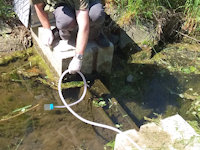

The program of both seminars was similar. At the seminar in České Budějovice, a little more emphasis was placed on contributions about Krvavý and Kačležský pond SAC and Horní Malše SAC. Only here was also be a lecture by Austrian colleagues about the invasive signal crayfish. In Prague, on the other hand, colleague Stein I. Johnsen from Norway shared his experience with the regulation of signal crayfish and the fight against crayfish plague.
Invitation to a seminar in České budějovice: pdf document (602 kB, Czech)
Invitation to a seminar in Prague: pdf document (601 kB, Czech)
Attendance lists: pdf document (1.6 MB, Czech)
Presentation - Představení projektu (P. Kožený): pdf document (2.3 MB, Czech)
Presentation - Invazní druhy - legislativa (T. Görner): pdf document (1.6 MB, Czech)
Presentation - Regulace invazních raků (J. Svobodová) pdf document (5.4 MB, Czech)
Presentation - Šíření invazních raků (D. Fisher): pdf document (582 kB, Czech)
Presentation - Využití eDNA (A. Petrusek, M. Mojžíšová): pdf document (3.5 MB, Czech)
Presentation - Signal crayfish and crayfish plague in Norway (S. I. Jonhsen): pdf document (2.9 MB)
Presentation - Migrační bariéry - Besének (V. Macháček): pdf document (4.7 MB, Czech)
Presentation - EVL Zákolanský a EVL Stroupínský potok (J. Svobodová): pdf document (8.7 MB, Czech)
Presentation - Prostřední rybník Chabry (M. Buřič): pdf document (3,6 MB)
Presentation - Rak jako kořist a konzument (L. Veselý): pdf document (2.1 MB, Czech)
Presentation - Rak a perlorodka v Malši (K. Tichá): pdf document (1.3 MB, Czech)
Presentation - How we deal with crayfish (blattfisch): pdf document (3.1 MB)
Presentation - Kačležský rybník (P. Hesoun): pdf document (1.7 MB, Czech)
Photo gallery - Seminar in České Budějovice:
Photo gallery - Seminar in Prague:
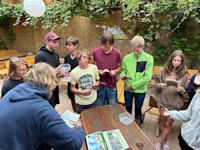
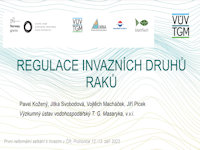
Presentation: dokument pdf (3.0 MB)
Abstract: dokument pdf (229 kB)
Proceedings: external link (Czech)
Press release: external link (Czech)

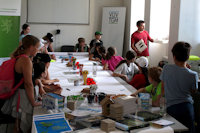
Additional information: external link (Czech)
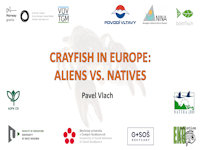
Presentation: pdf document (13.6 MB)

Presentation - EVL Zákolanský potok a mobilní aplikace „Raci v ČR“ (J. Svobodová): pdf document (3.0 MB, Czech)
Presentation - Regulace populací a šíření invazních druhů raků (P. Kožený): pdf document (2.8 MB, Czech)
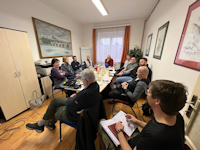
Attendance list: pdf document (258 kB, Czech)
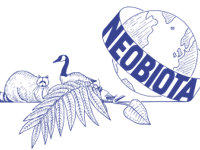
Poster: pdf document (5.1 MB)
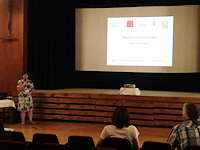
Presentation: pdf document (4.5 MB, Czech)
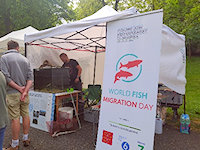
Invitation: pdf document (979 kB, Czech)
Information about the event: pdf document (732 kB, Czech)
World Fish Migration Day pages: external link
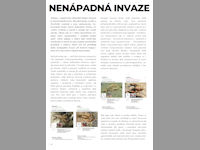
See: „Results“ tab
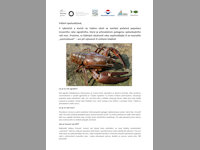
See: “Results” tab
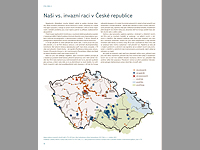
See: “Results” tab

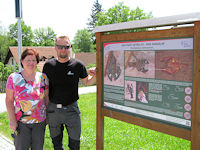
On Monday, after our Norwegian colleague's arrival in Prague, we visited Karáskův stream in Křivoklátsko with an occurrence of the stone crayfish (Austropotamobius torrentium), from which we took environmental DNA (eDNA) samples. The next visit was to Tyterský stream, where crayfish were introduced in 2020 from Bzovský stream, which was affected by crayfish plague in 2018. Manual monitoring has not yet found any crayfish, so eDNA was also collected from the stream. During the sample collection, we introduced our colleague to our eDNA sampling equipment and discussed the methodology of the work and interpretation of the results.
On Tuesday 30th May 2023, there was a trip to the Besének, which is a tributary of the Svratka in the South Moravian region. The protected noble crayfish (Astacus astacus) is found in the upper part of this stream, and the invasive signal crayfish (Pacifastacus leniusculus) spreads upstream towards Svratka. We introduced our Norwegian colleague to the system of migration barriers that we created during the project on the existing river bed drops against the spread of invasive crayfish. Together we carried out monitoring during which noble crayfish were confirmed in the area of Dolní Žleby. Furthermore, there was an inspection of the installed migration barriers lower on the Besének with a strong population of signal crayfish. From the Besének, we continued to Jindřichův Hradec via Telč.
On Wednesday 31st May 2023, we placed the bait traps in Kačležský pond with the occurrence of signal crayfish. We presented to our colleague the method of management in ponds and consulted on the usefulness of fish predation in the regulation of invasive crayfish in these systems. This was followed by a visit to Chlum stream and verification of the presence of crayfish. A massive die-off of crayfish was recorded in this stream in 2021, with the suspected influence of toxic metals leached from deforested areas.
On Thursday 1st June 1 2023, a visit to the Malše border section near the village of Leopoldschlag followed. In this SAC, there is a critically endangered freshwater pearl mussel (Margaritifera margaritifera), which is threatened by the invasive signal crayfish. Here, the bait traps were collected and invasive crayfish were caught by hand. In the afternoon, we returned back to Prague.
On Friday 2nd June 2023, the bait traps were collected from Prostřední rybník in Dolní Chabry. No crayfish were caught in the bait traps, but the subsequent catch using a landing net confirmed the occurrence of marbled crayfish (Procambarus fallax F. virginalis).
During the visit, we showed the partner most of the sites where we proceed according to the “Methodology for the regulation and eradication of invasive crayfish species: selection of appropriate methods depending on the nature of the water body” within the RAGO Norwegian Funds project “Application of innovative procedures in the eradication of invasive crayfish in the Czech Republic”. At the same time, we gained valuable experience from the procedures used in regulating invasive crayfish in Norway.
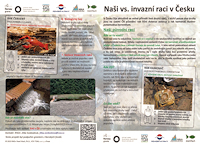
See: “Results” tab
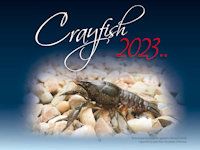
See: “Results” tab

